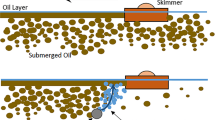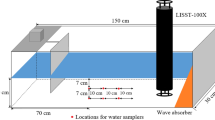Abstract
Recovering heavy oil spilled in a harsh environment is challenging especially when dealing with cold marine environments, where sea ice or high sea states are present. The current technology is based on removing oil from the water surface, meanwhile a significant amount of oil particles could remain in the water column due to turbulent ocean conditions and the density of heavy oil. Therefore, in order to enhance the mechanical recovery of heavy oil, capturing oil particles dispersed in the water column is very important. It has been observed that air bubbles can create an upward water flow and thus enhance the flotation of suspended oil particles. The oil floating at surface can then be removed using conventional skimmers. The present paper focuses on developing a lab-scale test program and Computational Fluid Dynamics (CFD) simulation for an enhanced oil spill recovery system and presents the preliminary test results performed at C-CORE. Both stationery and advancing modes of the oil spill recovery system with attached air diffusers were tested. Preliminary test results indicate that the heavy oil recovery ratio can be significantly improved by using air bubbles for oil flotation.












Similar content being viewed by others
References
Afenyo M, Veitch B, Khan F (2016) A state-of-the-art review of fate and transport of oil spills in open and ice-covered water. Ocean Eng 119:233–248
Agrawal M, Dakshinamoorthy D (2011) Computational analysis of oil spill in shallow water due to wave and tidal motion. Offshore Technology Conference, Houston, Texas, USA
Amini A, Schleiss AJ (2009) Numerical modeling of oil-water multiphase flow contained by an oil spill barrier. Eng Appl Comput Fluid Mech 3(2):207–219
Broje V, Keller AA (2006) Improved mechanical oil spill recovery using an optimized geometry for the skimmer surface. Environ Sci Technol 40(24):7914–7918
Bruce H, Mitchell V (2016) Oil spill response options in the outer continental shelf, Arctic technology conference. OTC-27433-MS, St. John’s NL, Canada
Dickins D (2015) Mechanical recovery in ice (summary report), Arctic Oil Spill Response Technology, Joint Industry Program
Mullin JV (2016) A joint industry Programme to improve oil spill response in the Arctic. Arctic technology conference. OTC-27431-MS, St. John’s NL, Canada
Otsuka N, Sato N (2002) Experimental study on oil/water separation system using conduit with circular cross section, proceedings of the 12th international offshore and polar engineering conference, Kitakyusha, Japan
Reed M, French D, Rines H, Rye H (1995) A three-dimensional oil and chemical spill model for environmental impact assessment. Proc 1995 Int Oil Spill Conf: 61–66
Standard Guide for Collecting Skimmer Performance Data in Controlled Environments, F631.38894
Tkalich P, Huda K, Hoong-Gin KY (2003) A multiphase oil spill model. J Hydraul Res 1(2):115–125
Versteeg HK, Malalasekera W (2007) An introduction to computational fluid dynamics, the finite volume method, second edn. Prentice-Hall, Edinburgh Gate, Harlow
Zhu H, Lin P, Pan Q (2014) A CFD (computational fluid dynamic) simulation for oil leakage from damaged submarine pipeline. J Energ 64:887–899
Acknowledgements
This project was supported by Natural Resources Canada (NRCan) under Oil Spill Response Science (OSRS) program and by Department of Tourism, Culture, Industry and Innovation (TCII) of the Provincial Government of Newfoundland and Labrador. The project team appreciates the great support from these Federal and Provincial programs for the present work.
All recovery equipment used in the project e.g. skimmers, hydraulic power units (HPU), and hydraulic hoses were provided in-kind by Elastec. The project team thanks Elastec for their generous support.
Eastern Canada Response Corporation (ECRC) provided feedbacks and technical recommendations before and during the course of the project. As the industrial corporation responsible for oil spill cleanup offshore Eastern Canada, it was a privilege having hands-on feedback to ensure applicability of the developed concept. ECRC also provided equipment to be used in the filed demonstrations (HPU, booms, and connectors). The project team would like to thank ECRC for their great support.
Author information
Authors and Affiliations
Corresponding author
Ethics declarations
Conflict of interest
On behalf of all authors, the corresponding author states that there is no conflict of interest.
Additional information
A publisher's error resulted in this article appearing in the wrong issue. The article is reprinted here for the reader's convenience and for the continuity of the special issue. For citation purposes, please use the original publication details; Talimi V, Thodi P, Abedinzadegan Abdi M et al. (2019) Enhancing harsh environment oil spill recovery using air floatation system. Saf Extreme Environ 1:27–37. https://doi.org/10.1007/s42797-019-00005-6.
Rights and permissions
About this article
Cite this article
Talimi, V., Thodi, P., Abedinzadegan Abdi, M. et al. Enhancing harsh environment oil spill recovery using air floatation system. Saf. Extreme Environ. 2, 57–67 (2020). https://doi.org/10.1007/s42797-020-00017-7
Received:
Revised:
Accepted:
Published:
Issue Date:
DOI: https://doi.org/10.1007/s42797-020-00017-7




